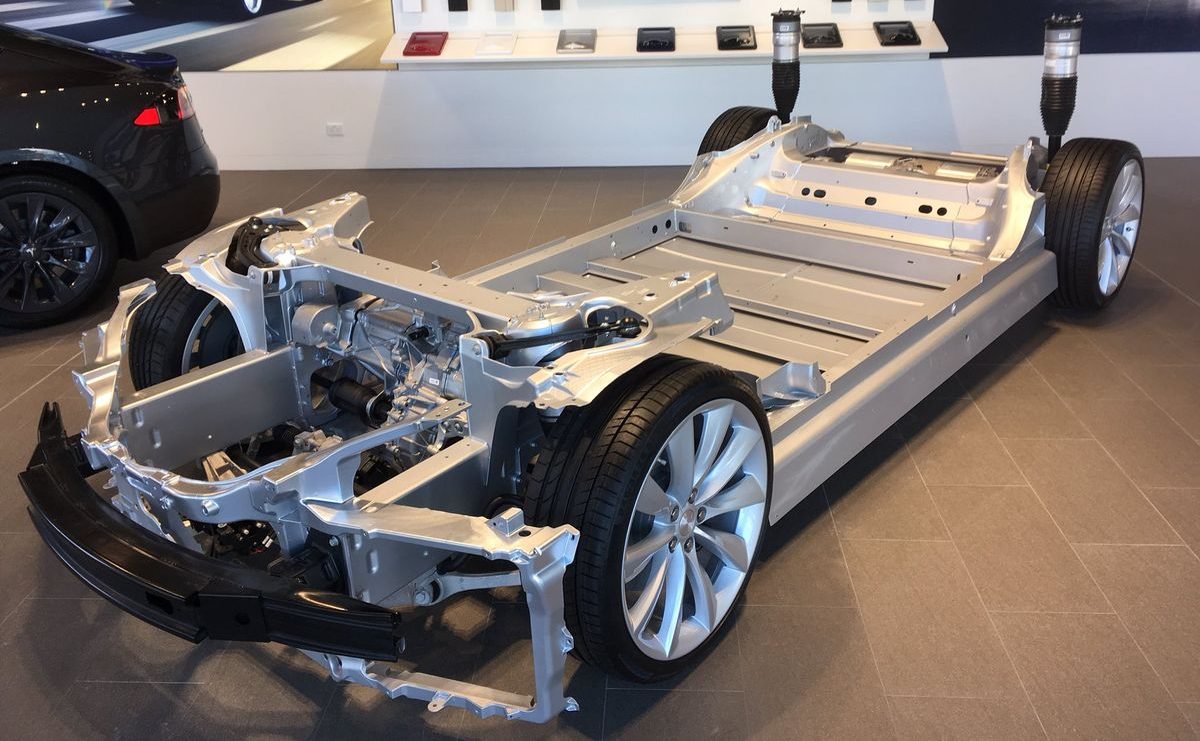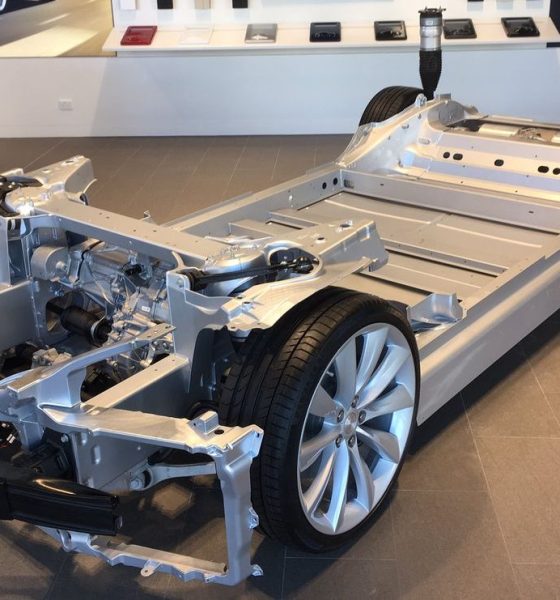

News
Tesla may supply batteries and drivetrains for Fiat-Chrysler EVs in the future, says CEO
Fiat-Chrysler might be lagging somewhat among veteran automakers when it comes to the development and rollout of its own all-electric vehicles, but the company might eventually get a valuable lifeline. In recent comments, FCA CEO Mick Manley noted that Tesla may very well provide batteries and drivetrains for future Fiat-Chrysler electric cars.
The executive’s comments were related on Thursday, following the release of FCA’s earnings report. During a Q&A, Morgan Stanley analyst Adam Jonas inquired about the automaker’s relationship with Silicon Valley-based electric car maker in the future. Jonas initially asked about the amount that FCA is paying Tesla in its EV fleet pooling deal, but the CEO declined to address the question.
Manley did respond to a follow-up inquiry about whether Fiat-Chrysler will be open to purchasing an all-electric platform from Tesla. According to the CEO, a large-scale electrification initiative will indeed happen especially if FCA’s merger with the PSA Group would go through. For this to happen, Fiat-Chrysler will need a valuable ally that is well-versed with electric vehicle technology. That ally will be Tesla.
“It would be wrong of me to say no,” Manley said, adding that batteries and drivetrains will likely be among the components that FCA will be purchasing from Tesla. The CEO also highlighted the possibility of the company buying a “skateboard” platform from the electric car maker, which it would then tune for its various brands.
While the idea of Tesla acting as a supplier of electric vehicle components for veteran automakers may seem like an alien idea today, the company actually engaged in similar activities in the past. During Tesla’s early days, for example, the then-small EV startup supplied powertrains for Toyota, which was then a major investor in the company. Tesla also acted as a supplier for the batteries of Daimler’s Smart city cars.
While addressing this point, Manley added that Fiat-Chrysler’s pooling deal with Tesla will conclude in 2021. Yet, despite this, the CEO noted that his company will remain committed to sustainability. “Our relationship with Tesla goes back a long way. It really has helped us. But FCA is absolutely committed to reducing CO2 emissions around the world,” Manley said.
The idea of Tesla serving as a supplier for other companies’ electric vehicles was mentioned in the company’s recently-held Q3 2019 earnings call. Similar to Manley, CEO Elon Musk seemed optimistic about the idea of Tesla selling its components to other OEMs. Addressing the topic, Musk stated that such initiatives are in line with the electric car maker’s mission.
“It would be consistent with the mission of Tesla to help other car companies with electric vehicles on the battery and powertrain front, possibly on other fronts. So it’s something we’re open to. As a lot of people know, we open-sourced our patents so that those would not serve as an obstacle to the adoption of electric vehicles or solar power or stationary storage. And we’re definitely open to supplying batteries and powertrains and perhaps other things to other car companies,” he said.

News
Tesla starts showing how FSD will change lives in Europe
Local officials tested the system on narrow country roads and were impressed by FSD’s smooth, human-like driving, with some calling the service a game-changer for everyday life in areas that are far from urban centers.

Tesla has launched Europe’s first public shuttle service using Full Self-Driving (Supervised) in the rural Eifelkreis Bitburg-Prüm region of Germany, demonstrating how the technology can restore independence and mobility for people who struggle with limited transport options.
Local officials tested the system on narrow country roads and were impressed by FSD’s smooth, human-like driving, with some calling the service a game-changer for everyday life in areas that are far from urban centers.
Officials see real impact on rural residents
Arzfeld Mayor Johannes Kuhl and District Administrator Andreas Kruppert personally tested the Tesla shuttle service. This allowed them to see just how well FSD navigated winding lanes and rural roads confidently. Kruppert said, “Autonomous driving sounds like science fiction to many, but we simply see here that it works totally well in rural regions too.” Kuhl, for his part, also noted that FSD “feels like a very experienced driver.”
The pilot complements the area’s “Citizen Bus” program, which provides on-demand rides for elderly residents who can no longer drive themselves. Tesla Europe shared a video of a demonstration of the service, highlighting how FSD gives people their freedom back, even in places where public transport is not as prevalent.
What the Ministry for Economic Affairs and Transport says
Rhineland-Palatinate’s Minister Daniela Schmitt supported the project, praising the collaboration that made this “first of its kind in Europe” possible. As per the ministry, the rural rollout for the service shows FSD’s potential beyond major cities, and it delivers tangible benefits like grocery runs, doctor visits, and social connections for isolated residents.
“Reliable and flexible mobility is especially vital in rural areas. With the launch of a shuttle service using self-driving vehicles (FSD supervised) by Tesla in the Eifelkreis Bitburg-Prüm, an innovative pilot project is now getting underway that complements local community bus services. It is the first project of its kind in Europe.
“The result is a real gain for rural mobility: greater accessibility, more flexibility and tangible benefits for everyday life. A strong signal for innovation, cooperation and future-oriented mobility beyond urban centers,” the ministry wrote in a LinkedIn post.
News
Tesla China quietly posts Robotaxi-related job listing
Tesla China is currently seeking a Low Voltage Electrical Engineer to work on circuit board design for the company’s autonomous vehicles.

Tesla has posted a new job listing in Shanghai explicitly tied to its Robotaxi program, fueling speculation that the company is preparing to launch its dedicated autonomous ride-hailing service in China.
As noted in the listing, Tesla China is currently seeking a Low Voltage Electrical Engineer to work on circuit board design for the company’s autonomous vehicles.
Robotaxi-specific role
The listing, which was shared on social media platform X by industry watcher @tslaming, suggested that Tesla China is looking to fill the role urgently. The job listing itself specifically mentions that the person hired for the role will be working on the Low Voltage Hardware team, which would design the circuit boards that would serve as the nervous system of the Robotaxi.
Key tasks for the role, as indicated in the job listing, include collaboration with PCB layout, firmware, mechanical, program management, and validation teams, among other responsibilities. The role is based in Shanghai.
China Robotaxi launch
China represents a massive potential market for robotaxis, with its dense urban centers and supportive policies in select cities. Tesla has limited permission to roll out FSD in the country, though despite this, its vehicles have been hailed as among the best in the market when it comes to autonomous features. So far, at least, it appears that China supports Tesla’s FSD and Robotaxi rollout.
This was hinted at in November, when Tesla brought the Cybercab to the 8th China International Import Expo (CIIE) in Shanghai, marking the first time that the autonomous two-seater was brought to the Asia-Pacific region. The vehicle, despite not having a release date in China, received a significant amount of interest among the event’s attendees.
Elon Musk
Elon Musk and Tesla AI Director share insights after empty driver seat Robotaxi rides
The executives’ unoccupied tests hint at the rapid progress of Tesla’s unsupervised Robotaxi efforts.

Tesla CEO Elon Musk and AI Director Ashok Elluswamy celebrated Christmas Eve by sharing personal experiences with Robotaxi vehicles that had no safety monitor or occupant in the driver’s seat. Musk described the system’s “perfect driving” around Austin, while Elluswamy posted video from the back seat, calling it “an amazing experience.”
The executives’ unoccupied tests hint at the rapid progress of Tesla’s unsupervised Robotaxi efforts.
Elon and Ashok’s firsthand Robotaxi insights
Prior to Musk and the Tesla AI Director’s posts, sightings of unmanned Teslas navigating public roads were widely shared on social media. One such vehicle was spotted in Austin, Texas, which Elon Musk acknowleged by stating that “Testing is underway with no occupants in the car.”
Based on his Christmas Eve post, Musk seemed to have tested an unmanned Tesla himself. “A Tesla with no safety monitor in the car and me sitting in the passenger seat took me all around Austin on Sunday with perfect driving,” Musk wrote in his post.
Elluswamy responded with a 2-minute video showing himself in the rear of an unmanned Tesla. The video featured the vehicle’s empty front seats, as well as its smooth handling through real-world traffic. He captioned his video with the words, “It’s an amazing experience!”
Towards Unsupervised operations
During an xAI Hackathon earlier this month, Elon Musk mentioned that Tesla owed be removing Safety Monitors from its Robotaxis in Austin in just three weeks. “Unsupervised is pretty much solved at this point. So there will be Tesla Robotaxis operating in Austin with no one in them. Not even anyone in the passenger seat in about three weeks,” he said. Musk echoed similar estimates at the 2025 Annual Shareholder Meeting and the Q3 2025 earnings call.
Considering the insights that were posted Musk and Elluswamy, it does appear that Tesla is working hard towards operating its Robotaxis with no safety monitors. This is quite impressive considering that the service was launched just earlier this year.








